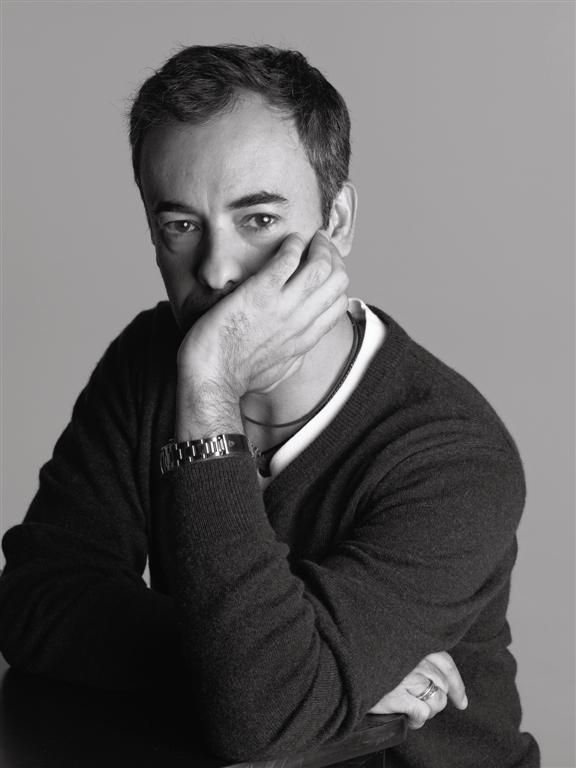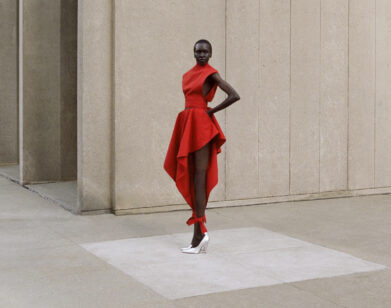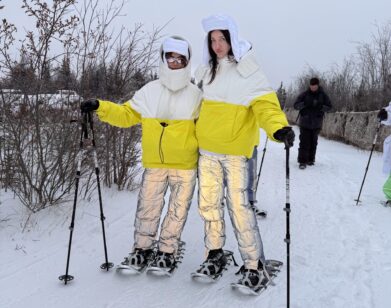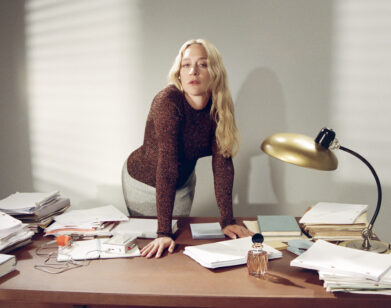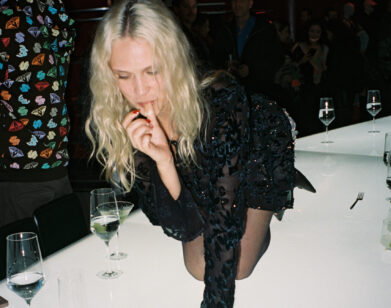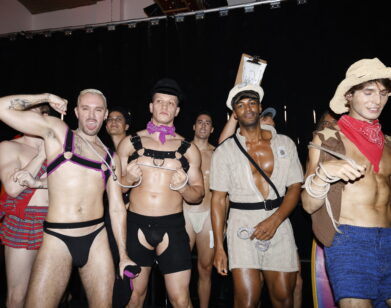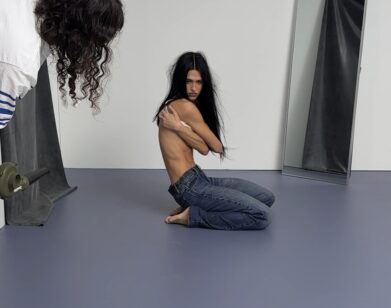Francisco Costa
There is something about a house that leads you to that one chair where you feel comfortable. Francisco Costa
When Francisco Costa was tapped five years ago to become the creative director for women’s wear at Calvin Klein, he assumed one of fashion’s most intensely scrutinized posts. Having worked behind the scenes for more than 15 years as a designer with the likes of Oscar de la Renta and Tom Ford, Costa was suddenly forced to grow up fast in front of the most judgmental eyes in -fashion and he did, becoming known for a thoughtful, luxurious minimalism that has never lacked in sensuality. In 2006, he won the coveted CFDA award for Women’s Wear Designer of the Year.
DAVID COLMAN: I have to start by asking you your sign.
FRANCISCO COSTA: Taurus. My birthday is May 10. I’m so Taurus, you would not even believe.
DC: What does that mean?
FC: All the Tauruses I know have this connection to the earth and the environment. We are very curious people, very loyal, very aware of and respectful of our surroundings. Also we’re stubborn, but that’s our way. We understand what we want, which is not bad.
DC: Have you ever been to a psychic?
FC: Yeah, 15 years ago. He told me that I was going to end up at Calvin Klein. I never told anybody. I was working at Oscar de la Renta at the time. It was bizarre. I would like to see this guy again, but I don’t know how to find him.
DC: Where were you born?
FC: In Brazil. Southwest of Rio, in the small town of Guarani near the state of Minas.
DC: Do you miss Brazil?
FC: Miss Brazil?
DC: Are you Miss Brazil?
FC: I was last year, but then I had to surrender the crown. [laughs] I do go back to Brazil once a year. I miss my family.
DC: Who in your family do you look like?
FC: My father. He’s more ethnic-looking. Dark hair. My mother was very tall, very Portuguese.
DC: Who do you take after?
FC: My mom. She was quite a character. Open-minded. It was a very small town, and she started her own business, manufacturing children’s wear. She was very dynamic. Her death was like the umbilical cord being cut, you know? That’s when I moved to America.
DC: How old were you?
FC: Twenty-two. I moved to New York and took classes at Hunter College—English as a second language. Then I went to FIT.
DC: What was your impression of American fashion at the time—specifically Calvin Klein?
FC: You thought about those Brooke Shields ads. I didn’t know who Calvin was, really. But Brooke, we knew her from those incredible commercials—“There’s nothing between me and my Calvins.” It chilled you to hear that on television. But I knew very little about American fashion then. I had no money, and Charivari was very educational to me. And Parachute. I was fascinated by those stores. I couldn’t buy anything; I just went through the clothes. “How can I go to Area if I don’t have this T-shirt?” You go through that when you get to a big city. I wasn’t part of any scene. I wasn’t a club kid. I wasn’t an artist. I was just a foreigner, trying to soak it all up. I had quite a lot of fun.
DC: Mid-’80s in New York was an amazing time.
FC: It was fantastic. I remember my first Gay Pride parade in the city. Where I grew up was very sheltered, so when I got to the city, there was this freedom and so much happening. At the same time, there was this pressure of AIDS and everything else. New York is so different today.
DC: Oscar de la Renta was your first big break?
FC: I was with Bill Blass, and then I got a promotion to go to Oscar. The company that I worked for owned both. At Oscar, I started on the licensing program, and we got to travel to Japan and do bags, accessories, coats. Then, two years in, I started a line called Oscar de la Renta Pink Label, which was very much about what he did, but more affordable. It was very successful, so he said, “Come work for me in the studio.” That’s when I really got to know Oscar. It was incredible. I could never before say that I loved color or that I understood color. But Oscar opened up a side of my brain.DC: Was it a big jump to go from there to Gucci?
FC: Huge. A woman with a strong French accent called. I thought she wanted to sell me prints. She said, “I’m a headhunter.” I said, “So why are you calling me? I’m so happy here.” She wanted me to see somebody, but she wouldn’t say who. So I said, “Thank you very much.” A week or two later, she called back and said, “It’s Gucci. I have an appointment for you with Tom Ford at 11 o’clock tomorrow morning, and you have to meet him.” I didn’t even have a portfolio, but I went to Tom the next morning. He said, “I’d love you to come in with me. Get a lawyer.” [laughs] It was quite exciting, obviously, because it was a complete departure. But mind you, what he was looking for was the exact opposite of what I thought. My first collection for him was Cher-inspired. It was flower trousers, California, hippie cool, all the stuff I did at Oscar. It was making me sick. I wanted to see the other side of the spectrum. Tom was always very secure about the way he did things, so it was quite interesting for me.
DC: How would you contrast your way of working with his way of working?
FC: You can’t compare us, but I do think that Calvin influenced his way of working. Calvin created this whole aesthetic with imagery—the whole sex thing. I can see that Calvin influence on his work. What Calvin has created is untouchable. My legacy, whatever it is I’m doing here, is miniscule compared to what he has done. It’s just like an update deal.
DC: Today all these influential designers work at houses where the name of the house is better known than their own. How do you feel about your name not being on the house?
FC: It’s a great thing. It’s so hard to actually find that niche for yourself. It’s like when Nicolas Ghesquiére found Balenciaga. I hate to sound esoteric, but there is something about a house that leads you to that one chair, that one corner, where you just sit and feel comfortable. I feel very comfortable at Calvin. My name is associated with it enough, and we have a fantastic team here. You think of luxury when you think of Calvin. He created this lifestyle that’s really desirable, so our whole project has that quality of being lasting.
DC: Some say you should never go work at a house where the designer is still alive. Do you feel pressure in that respect?
FC: I only do what I do. For me, it is a craft. It’s got to be my own thing—otherwise, I would never be successful. I could easily go to the archives and pull 1987 or 1991. But when you look in there, you realize that it was never about one piece. It was about the collections as bodies of work.
DC: Everybody seemed to really like your fall collection a lot. What was that about for you?
FC: It’s really about maturity and taking the texture, fabric, and all that to the next level-making a product that’s more substantial, more joyous.
DC: Who is your customer?
FC: She’s mature, intellectual . . . the kind of woman who wants to be on top. She has a fresh, young approach, but she’s very sophisticated. Think of Catherine Deneuve in Belle de Jour [1967]. . . . She is collected. . . . She’s smart. She’s sexy and she’s getting sexier. . . .
DC: The appeal of Belle de Jour is that it presents a woman as an entire creature.
FC: That’s the spirit. I would love to see these clothes 10 years from now, because the fabric is so amazing. They have that kind of strength that you carry through your life.
DC: The Calvin Klein runway presentations are always sober and understated. Do you ever envy someone like Marc Jacobs, who has these grenade-launching shows?
FC: No. The runway presentations are modest, but there’s substance behind them. Hopefully the clothes will speak louder. At times, you do dream, because when you think of Calvin, you think of the luxury of spaces. I do wish that we could do a show in some sort of open space. We’ll do it someday.
DC: And are you glad to not be doing florals?
FC: I love floral. I should quote Calvin here. “There is nothing good. There is nothing bad. It’s that everything you do is within a context.” We have tons of florals from Calvin himself. I just don’t think this is a floral moment for us.
DC: What was it like to work with Calvin? You didn’t overlap too much.
FC: A year. It was fantastic. He loved fabric. Our first fabric selection with Calvin, there were about 15 suitcases of uncut blankets. He had one pattern done in five different blend mixes, and every blend mix had 12 colors. It took two or three weeks to make one selection. It was marvelous. These fabric developments were really the core of the business. You have the same silhouette, but really vamped in fabrics. It is something that few companies did. Calvin has fantastic taste.
DC: He is also an amazing provocateur. Do you desire to be provocative?
FC: The more work we do, the more room we have. My interest is in this company, a huge corporation. I’m not saying that we have limitations, but it’s not the same freedom.
DC: Are you a big orchid fan?
FC: It’s a signature of the house, but at home I like greens more than flowers. Green. I’m a Taurus.
DC: You love book shopping, too, right?
FC: I don’t love reading so much, but I love book shopping. [laughs] It’s just because I don’t have much time. When I came back from Maastricht [the European Fine Art Fair, in the Netherlands], I went to this amazing show and bought 25 books.
DC: The work at Maastricht is incredible.
FC: It is. Of course, you can’t touch anything.
DC: Do you prefer Maastricht to Art Basel Miami?
FC: Actually, Miami Basel feels over-the-top.
DC: Are you a Miami person?
FC: Not really.
DC: Do you ever feel like people expect you to celebrate Latin things more?
FC: I think perhaps people are surprised that I don’t. I don’t think I put myself in a category. You know, I like cold. I really like to go to cold towns.
DC: And do you like gray?
FC: I love gray. I love winter.

